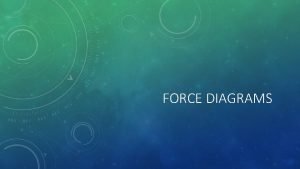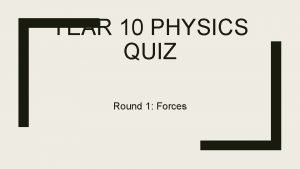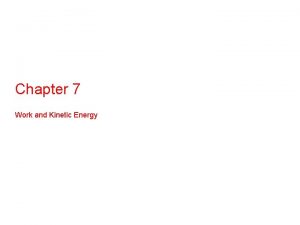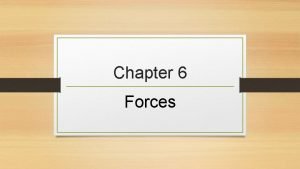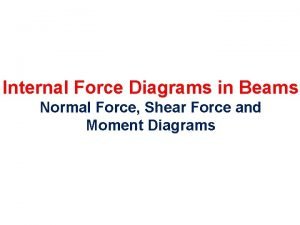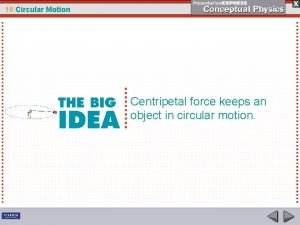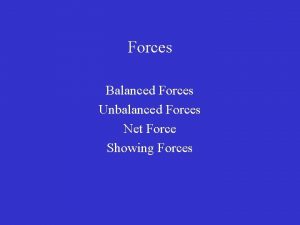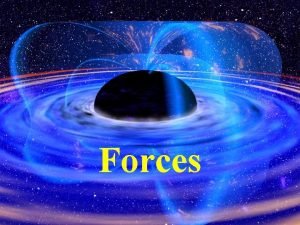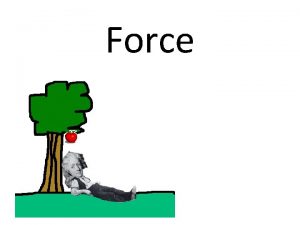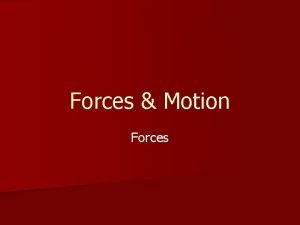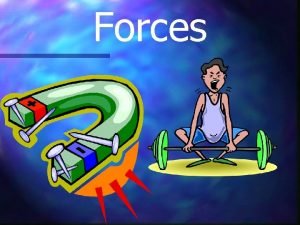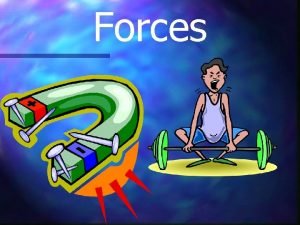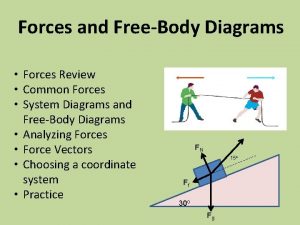FORCES What is a force A force is
















- Slides: 16

FORCES

What is a force? • A force is a PUSH or a PULL. • Forces do not have mass nor do they occupy a space. • Forces can – tear, bend, twist, or stretch an object. – Change the direction of the motion • Measured in Newtons (N)

2 main types of forces • Contact forces – A force between two objects in direct contact with one another. v. Frictional • Non-Contact forces – Forces that can act on objects at a distance and between two objects which are not in direct contact with one another. v. Magnetic v. Gravitational

Gravitational Force • Pulls objects towards the center of the earth • Objects exert a force of attraction on all objects around it. – The force may be small that we can’t feel it. • The larger the mass, the stronger the gravitational force – The sun’s gravitational force pulls smaller bodies towards it • The closer the two objects are, the stronger the gravitational force

Gravitational force • Objects fall to the ground at the same rate, regardless of their mass in the absence of air • Overcoming gravity: – Energy is needed to overcome gravity – More energy if you’re going against it – Less energy if you’re going towards it.

Gravitational energy in our daily lives

Frictional Force • A force that opposes motion. • Produced when two surfaces are in contact with each other • Can cause an object to move slower • More friction is exerted if the object’s mass is great • Surfaces play a role in the amount of friction generated

Frictional Force • Types of friction – Sliding • Two solid objects with one object sliding over the other • snowboarding – Rolling • When a circular object rolls over a surface • cycling – Fluid • Involves a solid object moving through a wet or fluid (liquid or gas)surface • Parachuting, wakeboarding

Infer the friction generated in the given pictures

Frictional energy • Energy is required to overcome friction. • How much energy is needed to overcome friction over smoother surfaces? • How much energy is needed to overcome friction over rougher surfaces? • When is frictional energy beneficial? When is frictional energy harmful?

Frictional energy in our lives

Magnetic Force • A force of attraction that pulls unlike poles. • A force of repulsion that pushes like poles. • A MAGNET attracts magnetic materials, which include those made up of Iron, steel, cobalt and nickel

Magnetic force • A stronger magnet exerts a stronger force of attraction – The material may move faster – A stronger force is needed to overcome a stronger magnet N S

Magnetism in our daily lives

The PENDULUM String e c n ta is s e ir r A Metal ball gravity

The PENDULUM • Found in clocks; has a weight and a string • Air resistance (frictional force) and gravity affect the motion of the pendulum • The length of the string also affects the time for the pendulum to complete its swings
 Intermolecular force of attraction
Intermolecular force of attraction The forces shown above are pushing/pulling forces
The forces shown above are pushing/pulling forces Contact and noncontact forces
Contact and noncontact forces Intermolecular forces from strongest to weakest
Intermolecular forces from strongest to weakest Force examples in everyday life
Force examples in everyday life Intermolecular vs intramolecular
Intermolecular vs intramolecular Destructive process examples
Destructive process examples What is a parallel force
What is a parallel force Body force vector
Body force vector Which of the following forces is a contact force? *
Which of the following forces is a contact force? * Centripetal force in geography
Centripetal force in geography Hooke's law vector form
Hooke's law vector form Long range force
Long range force Air resistance contact or non contact
Air resistance contact or non contact Internal forces
Internal forces If you whirl a tin can on the end of a string
If you whirl a tin can on the end of a string Is electric force a conservative force
Is electric force a conservative force








